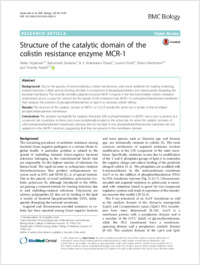Structure of the catalytic domain of the colistin resistance enzyme MCR-1
- Stojanoski, Vlatko Verna and Marrs McLean Department of Biochemistry and Molecular Biology, Baylor College of Medicine, Houston, USA - Department of Pharmacology, Baylor College of Medicine, Houston, USA
- Sankaran, Banumathi Berkeley Center for Structural Biology, Molecular Biophysics and Integrated Bioimaging, Lawrence Berkeley Laboratory, Berkeley, USA
- Prasad, B. V. Venkataram Verna and Marrs McLean Department of Biochemistry and Molecular Biology, Baylor College of Medicine, Houston, USA
- Poirel, Laurent Department of Medicine, Medical and Molecular Microbiology “Emerging Antibiotic Resistance” Unit and European INSERM Laboratory, IAME, University of Fribourg, Switzerland
- Nordmann, Patrice Department of Medicine, Medical and Molecular Microbiology “Emerging Antibiotic Resistance” Unit and European INSERM Laboratory, IAME, University of Fribourg, Switzerland - University of Lausanne, University Hospital Center, Lausanne, Switzerland
- Palzkill, Timothy Verna and Marrs McLean Department of Biochemistry and Molecular Biology, Baylor College of Medicine, Houston, USA - Department of Pharmacology, Baylor College of Medicine, Houston, USA
-
21.09.2016
Published in:
- BMC Biology. - 2016, vol. 14, p. 81
English
Due to the paucity of novel antibiotics, colistin has become a last resort antibiotic for treating multidrug resistant bacteria. Colistin acts by binding the lipid A component of lipopolysaccharides and subsequently disrupting the bacterial membrane. The recently identified plasmid-encoded MCR-1 enzyme is the first transmissible colistin resistance determinant and is a cause for concern for the spread of this resistance trait. MCR-1 is a phosphoethanolamine transferase that catalyzes the addition of phosphoethanolamine to lipid A to decrease colistin affinity.Results: The structure of the catalytic domain of MCR-1 at 1.32 Å reveals the active site is similar to that of related phosphoethanolamine transferases.Conclusions: The putative nucleophile for catalysis, threonine 285, is phosphorylated in cMCR-1 and a zinc is present at a conserved site in addition to three zincs more peripherally located in the active site. As noted for catalytic domains of other phosphoethanolamine transferases, binding sites for the lipid A and phosphatidylethanolamine substrates are not apparent in the cMCR- 1 structure, suggesting that they are present in the membrane domain.
- Faculty
- Faculté des sciences et de médecine
- Department
- Médecine 3ème année
- Language
-
- English
- Classification
- Biological sciences
- License
- License undefined
- Identifiers
-
- RERO DOC 277702
- DOI 10.1186/s12915-016-0303-0
- Persistent URL
- https://folia.unifr.ch/unifr/documents/305155
Other files
Statistics
Document views: 79
File downloads:
- nor_scd.pdf: 205
- nor_scd_sm.pdf: 64

